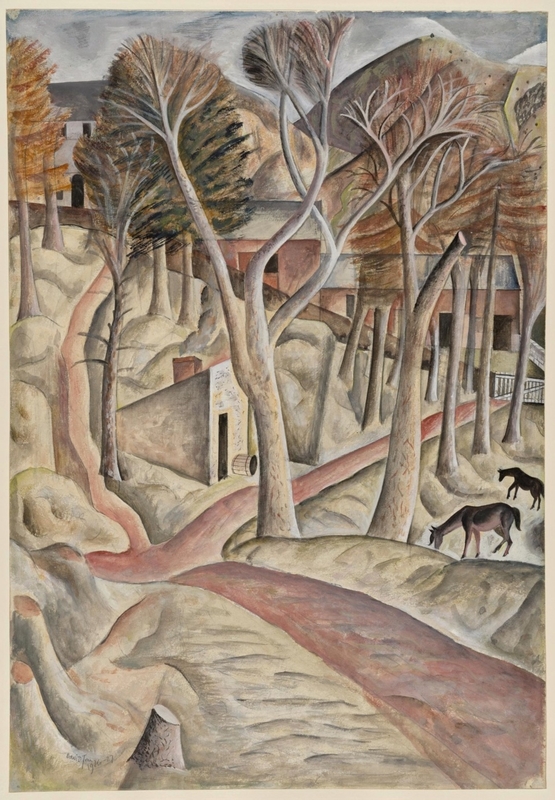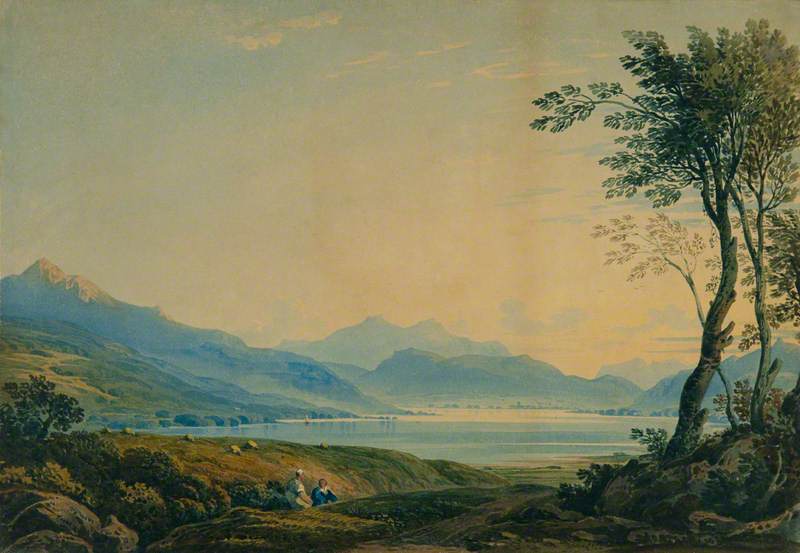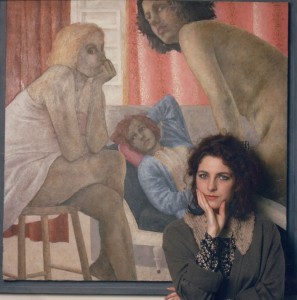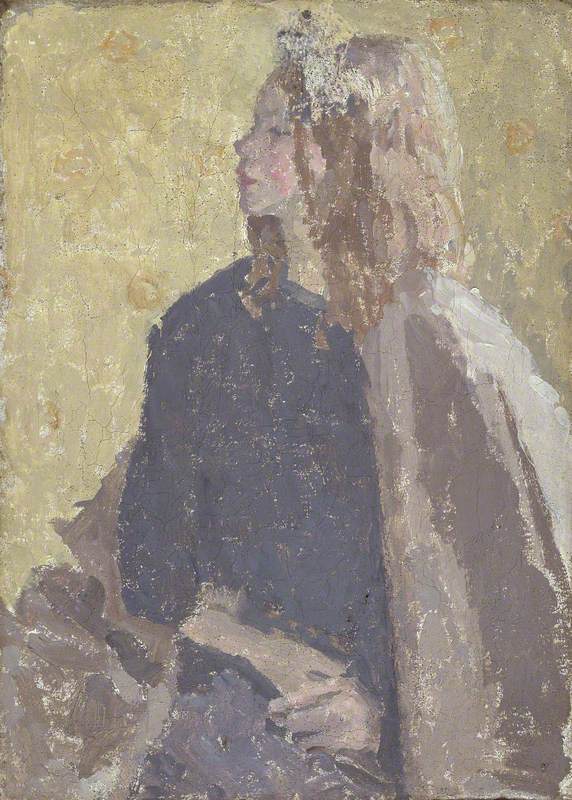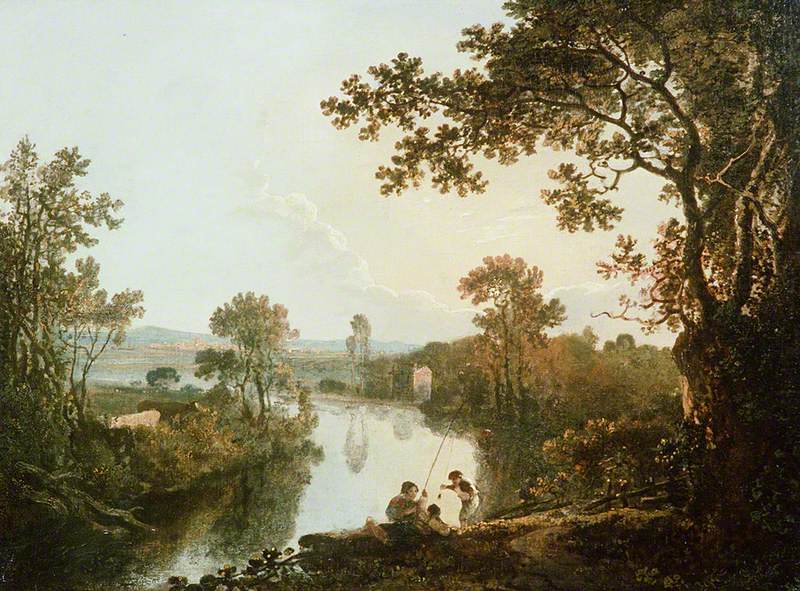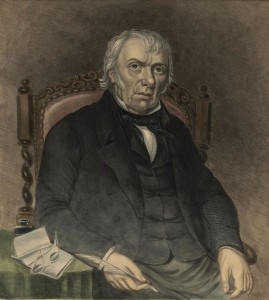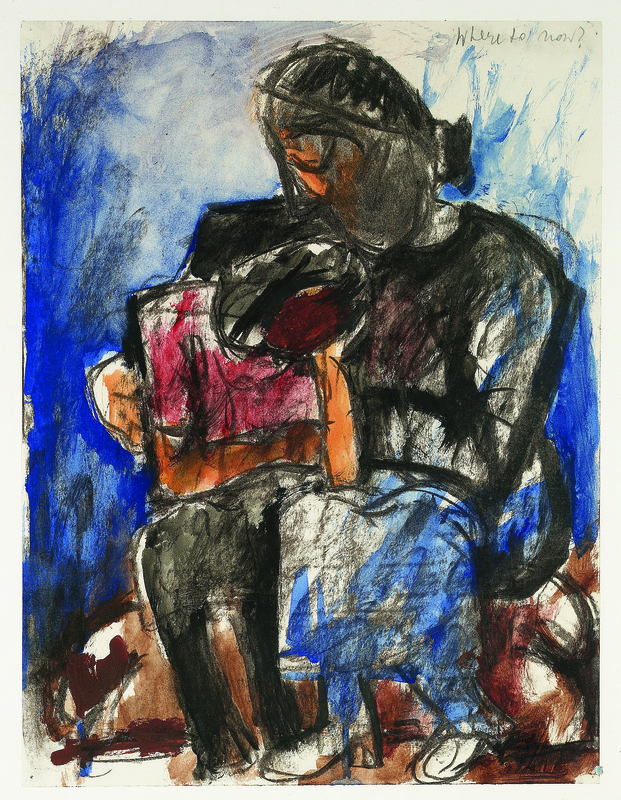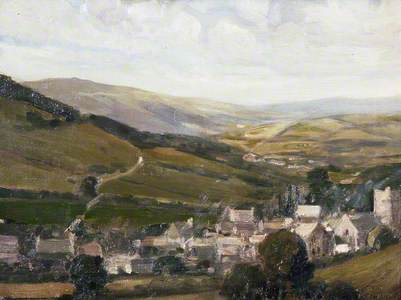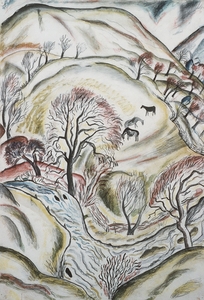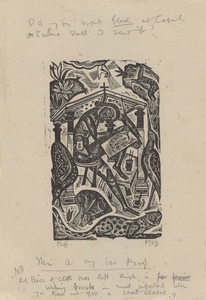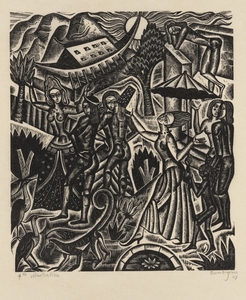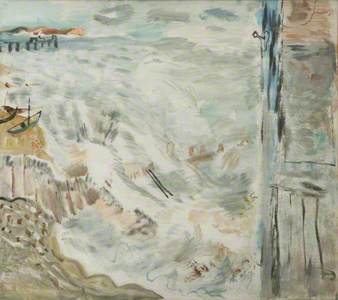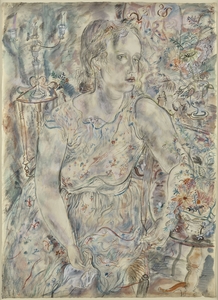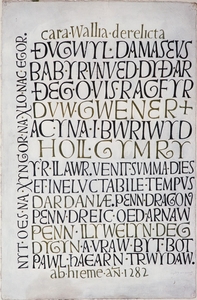In the mid-1920s, David Jones (1895–1974), though he was as yet unknown and unclear in his creative direction, was on the verge of becoming one of the great British artists of the twentieth century. After many years of art training and service in the trenches in the First World War, his work was still derivate and undistinguished. But this was all about to change.
David Jones
c.1930 by an unknown photographer 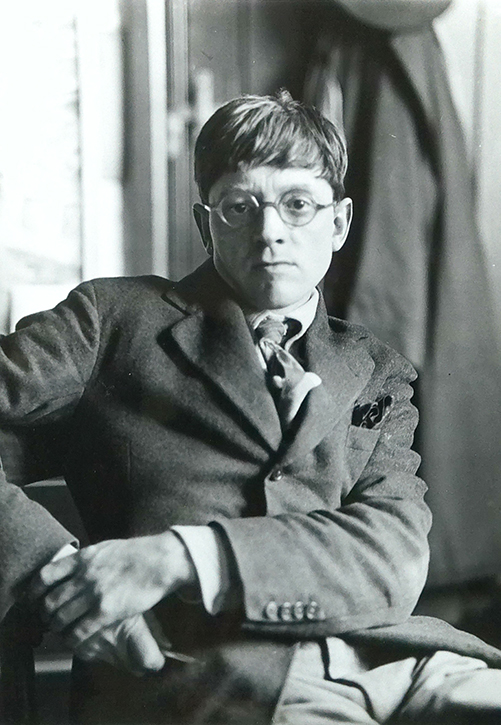
At the age of 29 in 1924, he began discovering new ways forward that established him as a brilliant and distinctive force in British art. Within a decade Kenneth Clark could describe Jones as 'the most gifted of all the younger English painters'. After his epic poem of the First World War, In Parenthesis, was published in 1937, he was called a genius by, among others, T. S. Eliot and Igor Stravinsky.
The Monastery at Capel-y-ffin, 2023
Pivotal to this transformation was Jones's time living and working at Capel-y-ffin, a hamlet and former monastery in the Black Mountains of south Wales. Looking back decades later, he described this as 'a new beginning'. He said: 'My subsequent work can, I think, be truthfully said to hinge on that period.' Even at the time, he was so sure of his new direction that he burned almost all his earlier paintings, saving only his wartime sketchbooks and some art school studies.
The exhibition 'Hill-rhythms' at y Gaer – Museum, Art Gallery & Library in Brecon is a rare opportunity to study Jones's work in detail, with over 70 works that reflect the importance of Capel-y-ffin to his development. His delicate watercolours need to be seen in the originals, yet conservation demands that they are seldom on display. Former Archbishop of Canterbury Rowan Williams, who opened the exhibition, said: 'This show includes, as well as some familiar pieces, a great deal of material from private collections that will be new even to seasoned admirers of David Jones, and confirms the importance of his time spent in Capel-y-ffin. It is a very significant event indeed.'
Jones arrived in Capel for Christmas 1924, to stay in the Roman Catholic artistic community set up in the former monastery by Eric Gill, after Gill quit Ditchling earlier that year. Jones was already engaged to Gill's daughter Petra. His first visit lasted ten weeks and he would return many times until February 1927, when Petra broke off their engagement. He never went to Capel again.
The Honddu Valley at Capel-y-ffin, 2023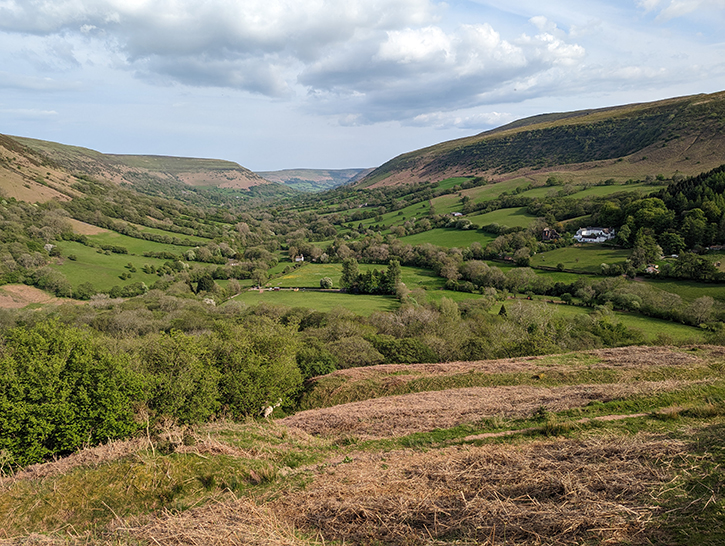
In the isolated valley of the River Honddu, 14 miles into the hills from Abergavenny, Jones found himself in the midst of a Welsh heritage that he sensed strongly from his father's family, even though he had grown up in London. The landscape of enclosing mountains and rushing streams was quite unlike the places he had known before – London, the rolling hills of Sussex and the flatlands of the Somme. He called it later 'a land of enchantment', a 'plurabelle'.
He had visited Wales before. In the summer of 1913 he was in the south-west, aged 17, 'trying to paint landscapes in the Teifi Valley.' A rare survivor of his early paintings is a view across the town of Tregaron that might have been done by any of a thousand British landscape painters of the time.
From the moment he arrived at Capel-y-ffin, Jones was set new challenges. He could not frame a traditional landscape composition with such high horizons. The subject rose up to fill the view. (When Eric Ravilious came to paint at Capel in Jones's footsteps a decade later he joked: 'the hills are so massive it is difficult to leave room for them on the paper.')
The southern extension of Darren Llwyd at Capel-y-ffin, 2023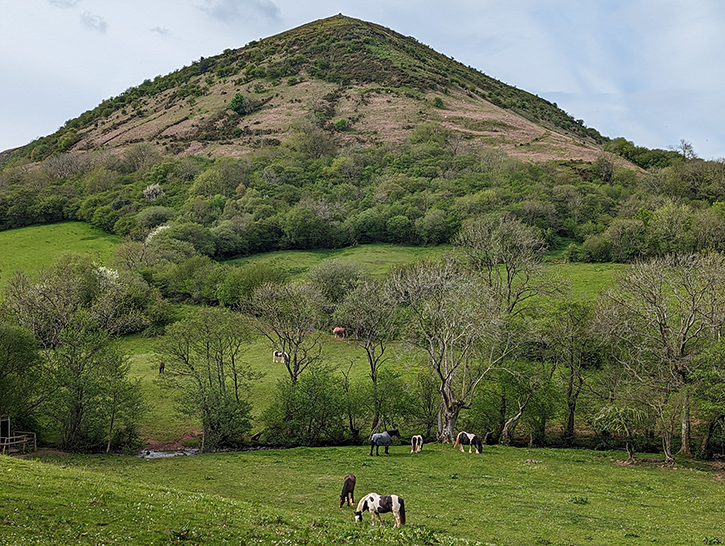
Jones started painting outdoors during that first Christmas, working quickly in the cold. In his early watercolour Tir y Blaenau he hit almost immediately on a breakthrough that freed him from the polite organisation of his previous landscapes. Jones would never part with the picture and said it was the one from which all his 'subsequent watercolour thing' developed.
Tir y Blaenau displays the 'strong hill-rhythms and the bright counter-rhythms' of the rivers that Jones would talk about, the convex arcs of the mountain and the field below it mirroring the concaves of the two riverbanks. The right side seems to be spinning away, the trees growing at right angles to the slopes, but the composition is stilled by the standing horses and bound together by laid hedges and spreading branches. He gives more-or-less equal tones to the far summit and the foreground river, compressing distance. The hill, the womb-like field and the curvaceous river show an anthropomorphic sensibility that he would pursue decades later in his poem The Sleeping Lord.
Tir y Blaenau was a breakthrough in technique too. He said he needed to be outdoors to capture the tensions that made for a 'live' painting, whereas working from memory produced easy lines and boring rhythms. He used crayon and ink fluidly and sparingly, and watercolour translucently, so that the white of the paper lends the whole a mid-tone that was to characterise almost all his work from this date onwards. He enjoyed watercolour's transparency, which permitted images to overlay one another – an equivalent of experiencing the world, where attention shifts and vision persists.
What has become clear, while gathering works from the Capel period for the exhibition, is that though Jones hit on the way forward early on, he continued to experiment. He tried another approach in a view of the monastery in February with snow still on the ground. The sharp angles and interpenetrating shapes give the painting an Art Deco quality, with a hint of Vorticism. It shows the monastery buildings on the right, the trees that separated them from the farm and the ghostly, semi-derelict chapel.
The Orchard, Capel-y-ffin
1924 (?), watercolour on paper by David Jones (1895–1974) 
In several paintings of the monastery orchard, he tried a mildly Fauvist approach, employing opposite colours to create an energetic effect, perhaps influenced by Henri Matisse or André Derain. In one that looks northwards to the sheltering mountain, he celebrates the Capel community's husbandry of the land: vegetable plots, straw bee skeps and a wooden hive, and new saplings planted alongside the bent old apple trees.
For Jones, 1926 was an auspicious year. He was at Capel for half the year, in winter, spring and summer, drawing obsessively even while working on major illustration commissions. Jones achieved the fluidity and movement he sought in all of his new paintings but especially in those with streams, mountains and woods. A view of a cascade shows his use of translucent washes that leave white paper and fine work in pencil. The layering in the sandstone riverbed rhymes with the ripples in the stream rushing away amid grass, ferns and trees.
It is clear that he was seeking to denote not just records of topography but signs of something beyond. Nature was, for Jones, a sign of God, a 'transubstantiation' – and by manifesting nature, art achieved a similar condition. His friend Nicolette Gray wrote that allusions 'come into his pictures because they are part of his mind, not because they are intended to be read by the beholder.'
He would explore, in later works, comparative mythology and connections between present and past as understood through Sir James Frazer's Golden Bough, and sources as diverse as the French Roman Catholic philosopher Jacques Maritain, Morte d'Arthur, the Gododdin, the Mabinogion and the Roman liturgy. He read most of these before or during 1926. Already in his Capel paintings, the mountain ponies might be seen as relics from the ancient armies lost in battles: 'Those straying riderless horses gone to grass in forest and on mountain'. The woods and trees may have brought to mind ideas about nature, refuge, the folklore of forests and the wood of the cross as well as the ravaged wood of Mametz, where he had been wounded in the war.
He made extended visits to the sister monastery of Capel-y-ffin on Caldey Island in Pembrokeshire. He experimented with a faux-naïve approach in both places and found a way of picking out details within in an image that became 'signifiers'. Caldy Island emphasises the coasters in the channel, the wall of dunes and the valley that insulated the monastery from the busy shore at Tenby. He confided in a letter that he saw the wood near the water's edge as 'very thrilling – like the Garden of Gethsemane + the Garden of the Tomb + the Garden of – well – the other sort of garden where Venus disports herself'.
The Ark is Completed
(or 'No rain – The Mock Continues', E165, The Chester Play of the Deluge) 1927
David Jones (1895–1974) 
Alongside the extraordinary development in his response to the landscape during his time at Capel, Jones was exploring other directions in his work. He applied his new thinking about landscape to pictures of the sea and established himself as an illustrator and engraver. It was at Capel that he met Robert Gibbings of the Golden Cockerel Press, and later Douglas Cleverdon, who commissioned him to illustrate The Rime of the Ancient Mariner. His masterpiece in wood engraving was The Chester Play of the Deluge, which he prepared at Capel, at home in Brockley and on Caldey. He brought to it his new fluidity and rhythm and set the story of the flood in the hills of Capel.
In the summer of 1927, a few months after the split with Petra had severed Capel-y-ffin from his life, Jones began spending time at a house his parents rented on the esplanade at Portslade near Brighton. There would be no more exploration of the hills, and his agoraphobia was now chronic but he could paint the English Channel from the house. Almost all his landscape paintings after around 1930 were views seen from inside. He wrote: 'I like the indoors outdoors, contained yet limitless feeling'. While framing scenes with windows was popular among artists at the time, including Winifred Nicholson and Christopher Wood, for Jones, it was a necessity.
The people Jones got to know in the communities at Ditchling and then Capel-y-ffin remained important to him. Conversations and reading there provided the intellectual foundations for much of his literary and artistic work. Soon after leaving, he made a series of portraits that captured many of the community. His most frequent subject was Petra Gill, and his greatest portrait of her was done when they became friends again after her marriage.
Petra im Rosenhag was titled in reference to the Renaissance tradition of depicting the Madonna in a bower of roses. Jones connects his former fiancée with several feminine archetypes – Mary, the goddess Diana, Flora in Botticelli's Primavera and Blodeuwedd, the woman made from flowers in the Mabinogion. Stylistically, the painting shows the free, rhythmic line that he had developed at Capel – here describing not woods and mountains but a woman and her surroundings. Flowers overflow along Petra's bare arm, a floral pattern covers her body, and the candles add to the impression of a shrine.
Countering the spiritual note, though, Jones conveys an earthy sensuality in the shape of Petra's breasts, the hem pulled up to show her petticoat and the carefully observed hair at her neck and armpits. She seems distant and unreachable and Jones makes a feature of her wedding ring. The picture belonged to Kenneth Clark, who said it had more of the artist's 'mind in it than anything else he did'.
Given how far David Jones continued to develop his work in the half-century from leaving Capel-y-ffin until his death in 1974, it is remarkable how the place continued to live in his imagination. Owing to problems with his eyesight as well as his increasing agoraphobia, he was no longer able to either engrave or immerse himself in landscape. He developed new forms of work, among them narrative paintings that drew on Arthurian legends, religious subjects, literature and myth. The locations were often a dreamlike version of the hills at Capel: there in his last major painting, Y Cyfarchiad i Fair, painted in 1962–1963. The Welsh title ('The Greeting to Mary') was supplemented by Annunciation in a Welsh Hill Setting.
The Annunciation in a Welsh Hill Setting
1962–1963
David Jones (1895–1974) 
It was 35 years since his last visit but the mountains behind the figures are the enclosing hills he had known, the wattle fence was based on one he helped to build in the garden at the monastery, and the flowers and animals were those he saw in Breconshire. The imagery is as interwoven as the fence, combining the Christian with Roman and Celtic myth. Mary is simultaneously Eve with the apple, yellow-haired Olwen and the goddess Rhiannon of the Mabinogion; Gabriel, arriving in a brilliant rush, is also Mercury, signified by birds at his heels. Thorns foretell the Passion and Gabriel bears not a lily but a sword of sorrow, struck by starlight rays that pierce Mary's heart. It is a painting in the tradition of annunciations since the Renaissance yet viewed through the associative mind of David Jones.
Jones found his 'plurabelle' at Capel-y-ffin and it remained intrinsic to his imagination, frequently resurfacing
In 1928, Jones began writing the text that would establish him as one of the greatest modernist poets. He started making images while in bed with the flu about his experiences in the Royal Welch Fusiliers. At first he wrote 'as a sort of running commentary', but the writing evolved into In Parenthesis. After completing a full draft in 1932, he had a nervous breakdown. The book combines an autobiographical narrative with layers of allusion to Welsh literature and history, mythology and Shakespeare's Henry V. On publication in 1937 it was hailed as a masterpiece.
Capel-y-ffin found an afterlife here too. In one passage he described the front with memories of Wales: 'Grey rain swept down torrentially. The water in the trench-drain ran as fast as stream in Nant Honddu in the early months, when you go to get the milk from Pen-y-Maes.'
Frontispiece to 'In Parenthesis'
1937
David Jones (1895–1974) 
He had barely been able to paint or draw for the past five years and he was not well enough to illustrate In Parenthesis as he intended. His drawing for the frontispiece was reproduced photographically. It is one of the most moving images a former soldier ever made of war. The half-naked central figure, either dead or shocked to numbness, evokes a crucifixion. He is an Everyman encumbered by army gear amidst a wasteland of smashed woods. Jones exhibited the picture during the Second World War with the title The Victim, when it stood both for his lasting trauma and for the tragic return of war.
He brought word and image together in painted inscriptions from around 1940. He said they were 'much more satisfactory to me than most of my work'. Cara Wallia Derelicta was his favourite and he hung it in his room. It drew on two medieval poems in Welsh and the Aeneid in Latin and memorialised the defeat of Llywelyn ap Gruffud that brought Wales under the control of the English crown – an historical event that meant more to Jones than any other save for the Last Supper and the Crucifixion.
In his own translation, the inscription begins at top and bottom, 'Dear Wales all buggered up since the winter of 1282'. The message at the centre compares the loss of Welsh nationhood with the fall of Troy, from which in legend Brutus came as a refugee and founded Britain.
In the 1950s Jones painted an extended series of still lifes of flowers in a glass goblet that he felt had 'a light of its own'. He called the goblet a cup, chalice or in Latin calix and the pictures signified water, light, life and the chalice on the altar for Mass. They were painted when he rarely left Northwick Lodge in Harrow, a residential hotel where he lived for most of his last decade in one room piled high with books and papers.
In Chalice with Flowers, he looks down on his table and out to the garden and Harrow School fields beyond – though the view is largely hidden. Below the flowers are sharp things – rose thorns, scissors, a knife – together with carefully detailed window furniture, a seal on a chain, an ink bottle and other objects. He was no longer the man who could wander the streams and hills at Capel to witness the transubstantive quality of wild nature and express it with freedom and movement, but he might yet find an equivalent in his room.
Jones found his 'plurabelle' at Capel-y-ffin and it remained intrinsic to his imagination, frequently resurfacing. For exhibition visitors today, nearly a century after his time there, the art of David Jones remains distinctive, beautiful and challenging.
Peter Wakelin, writer and curator
The exhibition 'Hill-rhythms: David Jones + Capel-y-ffin' runs until 29th October 2023 at y Gaer in Brecon. It is open daily and free to enter
An accompanying publication by Peter Wakelin is available at the gallery or direct from the publisher, Grey Mare Press
